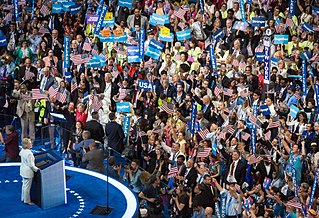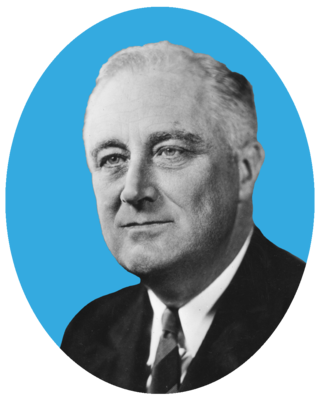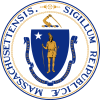
The Democratic National Convention (DNC) is a series of presidential nominating conventions held every four years since 1832 by the United States Democratic Party. They have been administered by the Democratic National Committee since the 1852 national convention. The primary goal of the Democratic National Convention is to officially nominate a candidate for president and vice president, adopt a comprehensive party platform, and unify the party. Pledged delegates from all fifty U.S. states, the District of Columbia, and the American territories, and superdelegates which are unpledged delegates representing the Democratic establishment, attend the convention and cast their votes to choose the party's presidential candidate. Like the Republican National Convention, the Democratic National Convention marks the formal end of the primary election period and the start of the general election season. Since the 1980s, national conventions have become mostly inaugural events for the winning candidate, since winners are announced long before the convention. In 2020, both major parties, and many minor parties, replaced their usual in-person conventions with virtual programs due to the COVID-19 pandemic.

EbenSumner Draper was an American businessman and politician from Massachusetts. He was for many years a leading figure in what later became the Draper Corporation, the dominant manufacturer of cotton textile process machinery in the world during the late 19th and early 20th centuries. He served as the 44th governor of Massachusetts from 1909 to 1911.

The 1952 Republican National Convention was held at the International Amphitheatre in Chicago, Illinois from July 7 to 11, 1952, and nominated Dwight D. Eisenhower of New York, nicknamed "Ike", for president and Richard M. Nixon of California for vice president.

Eugene Noble Foss was an American politician and manufacturer from Massachusetts. He was a member of the United States House of Representatives and served as a three-term governor of Massachusetts.

The 1932 Democratic National Convention was held in Chicago, Illinois June 27 – July 2, 1932. The convention resulted in the nomination of Governor Franklin D. Roosevelt of New York for president and Speaker of the House John N. Garner from Texas for vice president. Beulah Rebecca Hooks Hannah Tingley was a member of the Democratic National Committee and Chair of the Democratic Party of Florida. She seconded the nomination of Franklin Delano Roosevelt, becoming the second woman to address a Democratic National Convention. According to the White House Historical Association, Happy Days Are Here Again was the campaign song of the convention.

The 1854 New York state election was held on November 7, 1854, to elect the governor, the lieutenant governor, a Canal Commissioner and an Inspector of State Prisons, as well as all members of the New York State Assembly.

The 1893 New York state election was held on November 7, 1893, to elect the Secretary of State, the State Comptroller, the Attorney General, the State Treasurer, the State Engineer and a judge of the New York Court of Appeals, as well as all members of the New York State Assembly and the New York State Senate, and delegates to the New York State Constitutional Convention of 1894.

The United States Senate election of 1930 in Massachusetts was held on November 4, 1930. Incumbent Republican Senator Frederick H. Gillett did not run for re-election. In the open race to succeed him, Democratic Mayor of Fitchburg Marcus A. Coolidge defeated former U.S. Senator William M. Butler.

The 1878 Massachusetts gubernatorial election was held on November 5. Former acting Governor Thomas Talbot, a Republican, defeated Benjamin Butler, who ran as an independent Greenback candidate with Democratic support. Butler's supporters secured a majority of delegates to the Democratic state convention, but his nomination was rejected by the state party committee after his supporters used violent tactics to exclude anti-Butler delegates from the convention hall.

In the Chicago mayoral election of 1901, Democrat Carter Harrison Jr. was reelected to a third term, defeating Republican nominee Elbridge Hanecy by a 9.5% margin of victory.

Joseph C. Pelletier was district attorney of Suffolk County, Massachusetts, the first owner and president of the Boston Red Sox, and the Supreme Advocate of the Knights of Columbus. Despite success as a district attorney in successfully prosecuting Charles Ponzi, he later was removed as district attorney and disbarred for blackmail and extortion.

John B. Moran was an American politician who served as District Attorney of Suffolk County, Massachusetts, from 1905 to 1909.

William Alexander Gaston was an American lawyer, banker, and politician who was the Democratic Party nominee for Governor of Massachusetts in 1902, 1903, and 1926 and the United States Senate in 1905 and 1922. Outside of politics, Gaston served as president of the Boston Elevated Railway and National Shawmut Bank.

James Henry Vahey was an American lawyer and politician.

The 1857 Wisconsin gubernatorial election was held on November 3, 1857. After incumbent Governor Coles Bashford declined to seek re-election, Republican Party candidate Alexander Randall narrowly defeated Democratic candidate James B. Cross by a margin of just 118 votes.

The 1909 Massachusetts gubernatorial election was held on November 2, 1909. Incumbent Governor Republican Eben S. Draper was re-elected, defeating Democratic nominee James H. Vahey with 48.64% of the vote.

The 1902 Massachusetts gubernatorial election was held on November 4, 1902. Incumbent Republican Governor W. Murray Crane did not run for re-election. Lt. Governor John L. Bates was elected to succeed him, defeating Democratic nominee William A. Gaston and Socialist John C. Chase.

The 1907 Massachusetts gubernatorial election was held on November 5. Incumbent Republican Governor Curtis Guild Jr. was re-elected for a third one-year term.

John T. Coughlin was an American politician who served as mayor of Fall River, Massachusetts.

Norman Hill White was an American publisher and politician.























